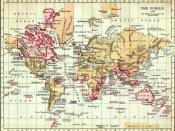Racism is a worldwide social problem that was developed through prejudice and ethnocentrism. Ethnocentrism is the belief or assumption that your own cultural and/or societal group is the most superior. Some people believe that Caucasians are considered the most superior race because they have used racism and ethnocentrism to mold this belief. In the book "Who Do We Think We Are? Race and Nation in the Modern World," written by Philip Yale Nicholson, he offers a provocative explanation of the force and place of race in modern history, showing that race and nation have a linked history. In his book, he also offered four very significant themes, which provides an insight to why racism still exists in our modern society.
Nicholson's first theme is extremely important because it explains the origin of racism. Nicholson hypothesize that the leaders of countries use the idea of race in order to create nations.
For stronger nations to be formulated, there should be a need for a strong sense of national pride. This sense of patriotism is easier to inspire when one considers the need to belong to a group. However, in order to give a definition of which a group may consist of, we first must decide whom the group excludes. Because skin color is the first thing that appeals to one another, it makes sense that it was chosen as a random basis for discrimination. The exclusions to the group are consequently stigmatized as biologically, mentally, or physically lacking in some way or another and thus inferior to those that fit within the included group. Unfortunately, this systematic way of discrimination on the basis of skin color is the formal creation of racism.
An example this was the accretion of anti-Semitism sentiments during World War II in Nazi Germany, which eventually led...


